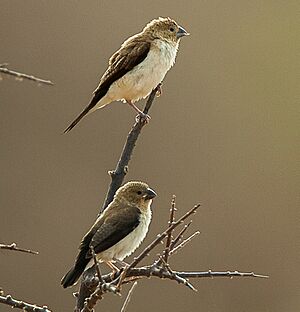African silverbill facts for kids
Quick facts for kids African silverbill |
|
|---|---|
 |
|
| In Kenya | |
| Conservation status | |
| Scientific classification | |
| Genus: |
Euodice
|
| Species: |
cantans
|
 |
|
| The Distribution of the African silverbill | |
| Synonyms | |
|
Lonchura cantans |
|
The African silverbill (Euodice cantans) is a small passerine bird. This means it is a type of perching bird. It used to be thought of as the same species as the Indian silverbill. This little estrildid finch lives in dry savanna areas south of the Sahara Desert. You can also find this bird in other places like Portugal, Qatar, and the United States, where it was brought by people.
Contents
About the African Silverbill's Name
The African silverbill got its official name in 1789. A German scientist named Johann Friedrich Gmelin gave it the scientific name Loxia cantans. The word "cantans" comes from Latin and means "singing."
Later, scientists decided to put the African silverbill and the Indian silverbill into their own special group, called the genus Euodice. This happened in 1862.
African and Indian Silverbills: Are They Different?
For a long time, people thought the African silverbill and the Indian silverbill were the same species. But in 1964, a scientist named Colin Harrison looked at them closely. He found that even though their calls sounded similar, their songs were quite different.
These two birds live in some of the same areas, like the southern Arabian Peninsula. But they don't usually mix or have babies together in nature. Studies have shown that they are very close relatives. They separated into two different species about one million years ago.
Types of African Silverbills
There are two main types, or subspecies, of African silverbills:
- E. c. cantans (named by Gmelin in 1789): These live from Mauritania and Senegal to South Sudan.
- E. c. orientalis (named by Lorenz von Liburnau and Hellmayr in 1901): These are found in the southern Arabian Peninsula, from eastern Sudan to Somalia and south to Tanzania.
What Does the African Silverbill Look Like?
The African silverbill is about 10 cm (4 in) long. It has a long, black, pointy tail. Adult birds have a short, silver-blue beak. Their upper parts are light brown with fine wavy patterns. Their undersides are whitish, and they have a black rump and black wings.
Male and female silverbills look very similar. Young birds, however, do not have the wavy patterns on their feathers.
Their Sounds
This bird makes a "tseep" call. It also has a trilling song. When a male wants to get in touch, he makes a single "tseep." Females make a double "tsiptsip" sound. When they fly, they often make a constant "tseep tseep tseep" sound.
The E. c. orientalis subspecies has a darker face and upper body than the other type.
Where Do African Silverbills Live?
African silverbills are found in many places. They like savanna areas, which are grasslands with scattered trees. They also live in dry areas with thorny bushes and open grasslands with acacia trees. You might even see them in farms and dry fields.
They are usually found in lower areas. But they can live in places up to 2,000 m (6,560 ft) high.
How Do African Silverbills Behave?
African silverbills are friendly and like to be around other birds. They often sit close together in trees in large groups. However, they are also quite calm birds. They can sit huddled together for a long time without moving much. They stay in flocks all year and usually nest together in loose groups.
What Do They Eat?
African silverbills mostly eat grass seeds. They pick seeds from the ground. They also take seeds directly from growing plants. They can hold onto grass stems to get seeds from the flower parts. It seems they mainly eat plants and feed their babies seeds too. Sometimes, they have been seen eating tiny insects called aphids from water mint plants.
How Do They Find a Mate?
When a male African silverbill wants to attract a female, he performs a special dance. He picks up a piece of grass in his beak. Then, he hops or flies close to the female. He smooths down his feathers, stands tall with his tail pointing down, and bobs his head up a few times.
Next, he leans forward and twists his tail towards the female. He also fluffs up the feathers on his sides and belly. At this point, he usually drops the grass and starts to sing and dance. The male might not always fluff his feathers. How much he displays probably depends on how well he knows the female. If the female seems interested, the male will try to mate. After successful mating, they might gently touch beaks and preen each other's feathers.
Building Nests and Raising Babies
The African silverbill's nest is usually a round shape made of grasses. It is lined with soft fibers and sometimes feathers. They often build nests in thick bushes, hedges, or among climbing plants on houses. The male bird is known to collect all the materials for the nest. The female helps build it.
A female silverbill usually lays three to six smooth, white, oval eggs. The female sits on the eggs during the day to keep them warm. The male might take over for her when she leaves to eat. Both parents stay at the nest at night. The eggs hatch in about 11 to 13 days. The young birds leave the nest in about 21 days. They become fully independent about a month after leaving the nest.
When baby silverbills first hatch, they are dark. They have bright yellow, waxy-looking mouths. Inside their white mouths, there is a single dark circle.
Are African Silverbills in Danger?
African silverbills are sometimes caught and sold as pet birds. However, there are many of them, and they live in a very wide area. This means that being caught for pets is not a big threat to the survival of the species.
Images for kids



